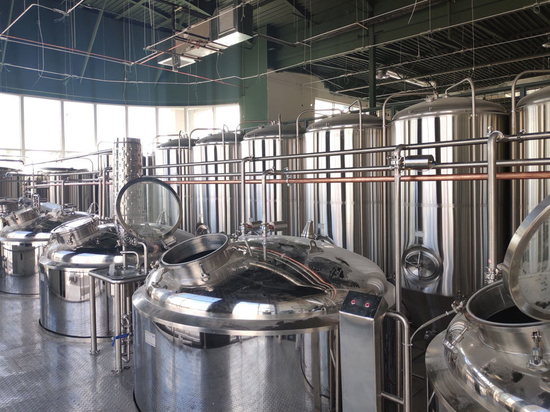
#Product Trends
Wort Lauter Tun Equipment
Lauter tun,beer equipment
The lauter trough is a wort Lauter Tun equipment often used in most breweries. In recent years, the equipment technology and process operation of the Lauter Tun have made great progress. The following mainly introduces the modern filter tank and its internal structure.
Modern lauter tun are generally made of stainless steel and have an insulation layer. In order to reduce oxygen absorption, the mash enters the lauter tun from the bottom. There are 2~6 adjustable mash inlet valves installed at the bottom of the lauter tank, and the mash pumping process should be completed within 10 minutes. To prevent inhalation of oxygen, the inlet velocity should not be higher than 1m/s. At the bottom of the sieve plate, install multiple cleaning nozzles evenly, and the distribution density is 2 nozzles/square meter. After the filtration, the bottom of the sieve plate can be washed with high-pressure water. This design not only greatly reduces labor intensity, but also can achieve good cleaning effect.
(1) Sieve plate
The sieve plate is 20mm from the bottom of the tank. Regardless of the type of sieve plate, the opening rate is generally 10%~30%, and the opening width is 0.5~0.7mm. The latest research shows that 10%~12% opening rate of the sieve plate is sufficient, because the most important factor affecting the filtration speed of wort is the thickness of the spent grains layer. Tiantai adopts welded seam sieve plate, which is made of stainless steel, the sieve plate seam width is 0.7mm, and the free circulation area is 18% of the total area of the sieve plate.
(2) Cultivator
The cultivator plays an important role in accelerating the filtration speed of wort and improving the quality of wort. In most cases, the first wort has been filtered and the spent grains have been tightly squeezed together. At this time, the resistance of the spent grains increases and the flow of wort decreases. At this time, it is necessary to use the tiller to loosen the grains to reduce the resistance of the grains and accelerate the filtration of the wort. In the process of grain washing, tillage can improve the contact between water and grains, add new wort channels, make the wort filter faster and wash grains more thoroughly.
Depending on the size of the lauter trough, the tiller can be equipped with two, three, four or six tiller arms. The larger the capacity of the filter tank, the more the number of tiller arms. At the same time, the time for one revolution of the cultivator is also longer.
The tillage knife is a part fixed on the tillage arm, and its design shape and distribution must ensure the uniformity of tillage and avoid the formation of tillage blind spots. There are three main types of cultivating knives: single-leg cultivating knife, double-leg cultivating knife, and bow-shaped cultivating knife.
To install tiller blades on the tiller arm, the requirement is that the tillage tracks of each tiller blade do not overlap each other. The distance between tiller blades on the tillage arm is different: within 1/3 radius, the distance between tiller blades is 240mm; within the range of 1/3~2/3 radius, the distance between tiller blades is 220mm. The distribution of tillage knives on the opposite sides is asymmetrical, and their motion trajectories are complementary, so that the purpose of uniform and fine tillage can be achieved.
The requirement of using the tillage machine is to cut the layer of wheat grains without destroying the formed filter layer. The speed of the tiller can be adjusted steplessly, and at the same time, the tiller can cut and loosen the grain layer at different heights, water flows into the grain layer along the shear line, and the adjacent parts are washed out. For example, in order to reduce the resistance of the grains when the first wort is filtered, the tiller can be rotated about 1-2 cm above the filter plate. When the second wort is filtered, turn the grain cultivator properly to make the resistance of the grains within a certain range, so as to ensure that the washing water evenly penetrates into the grain layer. In addition, the arrangement of cultivating knives should not be too dense, and should be adjusted according to the crushing situation. For example, the spacing of cultivating knives for wet crushing is about 50% higher than that of dry crushing; Wash evenly and thoroughly.





